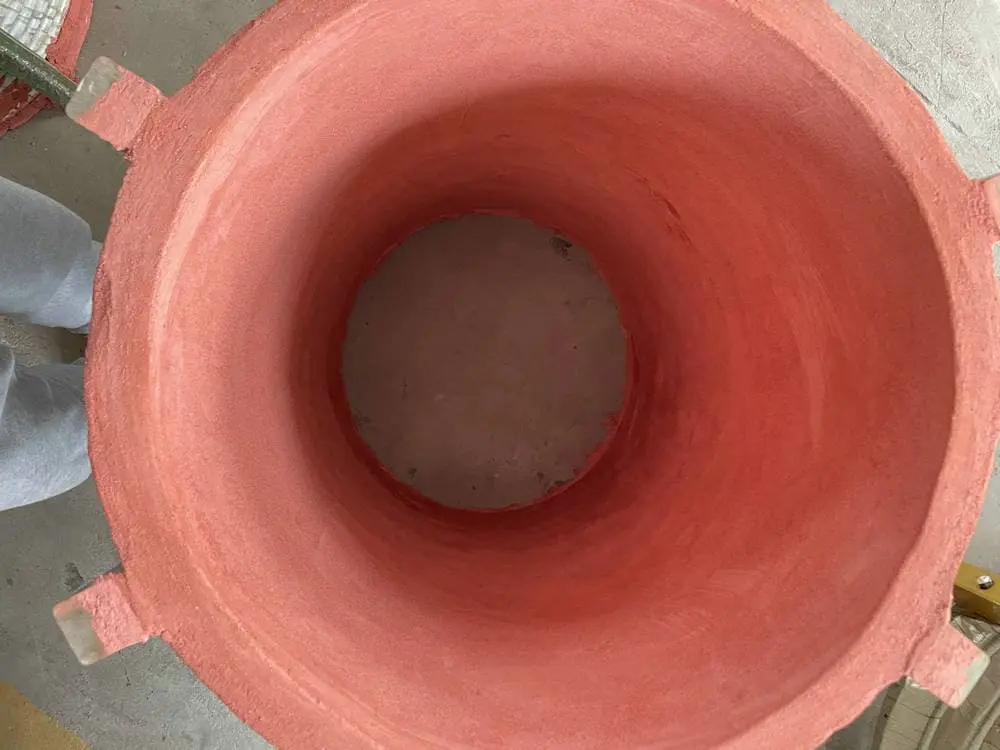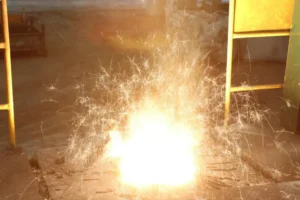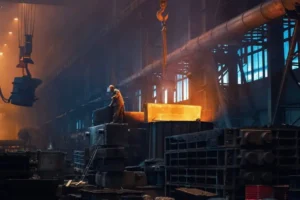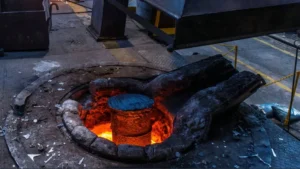In modern foundry and metallurgy, the induction furnace is favored for its high efficiency, ความสะอาด, และควบคุมอุณหภูมิได้อย่างแม่นยำ. อย่างไรก็ตาม, ที่ “หัวใจ” of the furnace—the lining—directly determines the success or failure of production. Selecting the right refractory material and applying a skilled installation process is an “art” that combines science and experience.

The Science of Selection: Know Your Refractories
Induction furnace linings, typically dry ramming mixes, are classified into three main categories based on their chemical composition and reaction to slag: ที่เป็นกรด, Neutral, and Basic.
1. Acidic Linings
- ส่วนประกอบหลัก: High-purity silica (SiO₂), usually > 98.5%.
- Characteristics:
- ข้อดี: Relatively inexpensive, good thermal conductivity, and strong resistance to acidic slag.
- ข้อเสีย:Poor thermal shock resistance (prone to cracking during rapid temperature changes) and cannot withstand basic slag.
- หลัก แอปพลิเคชัน: ละลาย เหล็กหล่อ (grey, ductile) and some carbon steels. The slag generated from these metals is typically acidic (SiO₂-MnO-FeO).
2. Neutral Linings
- ส่วนประกอบหลัก: Alumina-based (อัล₂O₃), such as corundum, mullite, or alumina-magnesia spinel.
- Characteristics:
- ข้อดี:Excellent thermal shock resistance, high mechanical strength, and good resistance to both acidic and basic slags (though not the strongest against either).
- ข้อเสีย: More expensive than acidic linings.
- หลัก แอปพลิเคชัน: The most versatile. Ideal for melting สแตนเลส, high-alloy steels, โลหะผสมทองแดง (ทองเหลือง, บรอนซ์), and in operations that frequently change alloys.
3. Basic Linings
- ส่วนประกอบหลัก: High-purity magnesia (MGO) or magnesia-alumina spinel (MgO·Al₂O₃).
- Characteristics:
- ข้อดี:Exceptional high-temperature performance และ strongest resistance to basic slags (high CaO, MGO).
- ข้อเสีย: Expensive, high thermal conductivity (can lead to more heat loss), and hygroscopic (must be stored in strictly dry conditions).
- Primary Application: Specifically used for melting specialty steels และ high-alloy steels that produce strongly basic slag during the refining process.
Refractory Comparison: At a Glance
| ลักษณะเฉพาะ | Acidic Lining (ซิลิกา) | Neutral Lining (Alumina/Mullite) | Basic Lining (Magnesia) |
| ส่วนประกอบหลัก | SiO₂ | อัล₂O₃ / Al₂O₃-SiO₂ | MGO |
| Slag Resistance | Excellent (vs. ที่เป็นกรด) | ดี (vs. Both) | Excellent (vs. Basic) |
| Thermal Shock | ยากจน | Excellent | ปานกลาง |
| Max. อุณหภูมิ | ปานกลาง (~1700°C) | สูง | สูงมาก |
| การใช้งานหลัก | เหล็กหล่อ, เหล็กกล้าคาร์บอน | สแตนเลส, Copper Alloys | Specialty Steels, High-Alloys |
| ค่าใช้จ่าย | ต่ำ | ปานกลาง | สูง |
The Key Takeaway: Your choice must be based on the type of metal you are melting and the nature of the slag it produces. Using an acidic lining to melt steel with basic slag (or vice versa) will result in rapid lining erosion and a drastically shortened life.
The Art of Installation: The Importance of Process
Choosing the right material is only 50% of the job. The other 50% depends on the installation process—namely, “ramming” และ “sintering.”
1. “Density”: The Ramming Process
Ramming (or tamping) is the process of filling and compacting the dry refractory material into the space between the furnace shell and the crucible former (template).
Why is it so important?
- Achieve Maximum Density: The singular goal of ramming is to pack the refractory grains as tightly as possible. ก high and uniform density is the foundation for resisting metal penetration and chemical attack.
- Prevent Lamination: The material must be rammed in shallow, even layers (เช่น, 5-10 cm at a time). Adding too much material at once will result in a compacted top but a loose bottom, creating a critical weak point.
- Eliminate Weak Spots: The joint between the furnace bottom and the sidewall is the most vulnerable area. Proper tools (like flat and sharp-pointed pneumatic rammers) must be used to ensure no corner is left loose.
What happens if ramming is poor?
- Metal Penetration: A loose lining cannot withstand the pressure of the molten metal, allowing it to “drill” into the refractory, leading to premature failure.
- Risk of Breakout: Once metal penetrates to the back of the lining and contacts the induction coil, it will cause an immediate short circuit, production shutdown, and potentially an explosion.
2. “Fire”: The Sintering Process
After ramming, the lining is still just a dense powder. Sintering is the process of controlled heating that causes the “working face” (the side touching the metal) to undergo chemical and physical changes, forming a hard, solid ceramic shell.
Why is it so important?
The goal of sintering is to create an ideal three-layer structure within the lining:
- Sintered Layer:
- ที่ตั้ง: Innermost layer, in direct contact with molten metal.
- State: Fully ceramified, forming a hard, strong shell.
- วัตถุประสงค์: Resists erosion, scouring, and penetration by the molten metal.
- Transition Layer (Semi-sintered Layer):
- ที่ตั้ง: Between the sintered and loose layers.
- State: Partially sintered, retaining some strength but also some flexibility.
- วัตถุประสงค์: Acts as a buffer for mechanical and thermal stress, preventing the sintered layer from cracking due to expansion or contraction.
- Loose Layer (Backup Layer):
- ที่ตั้ง: Outermost layer, nearest the induction coil.
- State: Remains in its original powder-like (or lightly cured) state.
- วัตถุประสงค์: This is a deliberate safety layer. Its low thermal conductivity protects the coil, and its loose nature provides a cushion for the entire lining’s thermal expansion.
What happens if sintering is improper?
- Sintering Too Fast/Hot: The lining can crack from excessive thermal stress. Or, the sintered layer becomes too thick, leaving the transition and loose layers too thin, making the lining “brittle” and prone to thermal shock.
- Sintering Too Low/Short: The sintered layer is too thin or fails to form at all. The lining remains “soft” and has no defense against the molten metal, leading to rapid failure after the first melt.
บทสรุป
The art of the induction furnace lining lies in the perfect marriage of scientific selection และ disciplined installation.
- Selection คือ “strategy”: You must choose the correct acidic, neutral, or basic material based on your melt (เหล็ก, เหล็ก, ทองแดง) and its slag.
- กระบวนการ คือ “tactic”:
- Ramming pursues “density” to build a physical barrier.
- การเผา pursues the “right heat” to build a strong yet flexible three-layer structure.
Neglecting any part of this process can lead to a short lining life, poor metal quality, and severe safety hazards.







